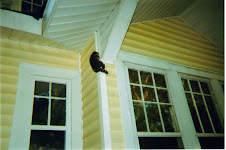I tried my hand today at leaf castings I have been seeing on different DIY shows on TV. I have a brief pictorial with this posting but forgot to take a shot of the sand pile with the bare leaf on the sand. So here are the steps as I did them. I chose a large elephant ear leaf that had good veins and ribs.
1. Cover work area with plastic and make some sort of holding pan for sand (I used an old water heater drain pan.
2. Mound up sand to form the basic shape of your chosen leaf and to the depth you want your bird bath, feeder, wall hanging - whatever you are making. I chose a "sit on the ground" birdbath.
3. Spray clear water on the pile of sand to moisten and cover with thin layer of plastic - I used a garden trash bag. This keeps sand from getting into the concrete mixture.
4. Lay your chosen leaf on top of the plastic over the sand pile. Choose a leaf with lots of deep veining as you will want to see these in the castings.
5. Mix your concrete in some sort of container near your work area - I used a large storage tote, water hose, hoe and flat shovel for the mixing. I used some "QuikRete"(tm) that was donated to the garden home by Darlene Millson.
6. Put on rubber dish washing type gloves. Then by hand fulls, start scooping up the slurry mixture and adding to the back of the leaf, patting gently toward the outer edges. Then when the entire leaf is covered, I pulled the bottom plastic up and used it to round up the edges of my mixture to give a finished edge. At this time I also added a large pedestal base that my birdbath will rest on. If you want to hang it as garden art, at this time you would add a cut-up metal coat hanger made into a hook and inserted or add a piece of pipe nipple if you want to use it on a rod raised up in the garden.
7. Now you spray the entire surface with misting, clear water and pat it smooth. Continue spraying until you see it like you want it and again I pulled the base plastic up to re-smooth the edges. By the way, one could pre-stain the concrete mixture if your chose to for a solid colorization.
8. When satisfied, pull the edges of the base plastic up around the form, cover with another piece of plastic and secure corners. This is to keep it from drying too fast which will cause the form to fracture.
9. Check the form later in the day and re-mist as needed if very hot, dry weather exist. Let dry for 24hrs then check again and spray again. Let dry for another 48hrs, spraying occassionally. Then check the casting and gently remove from sand pile and clean off leaf deposits gently with a soft brush or paint brush. This might not come off easily but will rot over time. You can gently use a screwdriver to clean out any deep grooves or veins that have plant material in it. Allow the casting to cure another 72-hrs before moving further. Wait 2-weeks more for complete curing then paint or stain your casting as you would like and you should be good to go.
WE WILL SEE HOW THIS TURNS OUT
Paint, By Numbers!
14 years ago






















Can't wait to see the finished product! What a great blog!
ReplyDeleteKathy M.
Thanks, Kathy M. I will check it today and see if I can ease it onto the ground off the table, keeping it in the shade for a few more days till it cures. I will post finished pics.
ReplyDelete